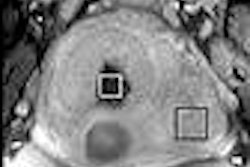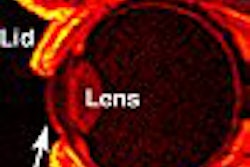Orthopedic physicians who buy in-office imaging equipment are often tarred with the self-referral brush by radiology professionals worried about losing turf in musculoskeletal imaging. But in many cases orthopods who install their own MRI scanners turn to radiologists -- in particular teleradiology services -- for assistance in reading musculoskeletal exams.
Orthopedic practices are installing in-office MRI scanners for a number of reasons, including the convenience of being able to image patients in their own offices rather than sending them to another facility. Imaging vendors have developed new scanner models designed specifically for in-office siting, giving orthopedic surgeons a more economical alternative to expensive whole-body systems.
ONI Medical Systems of Wilmington, MA, has installed OrthoOne, a 1-tesla extremity MRI, at more than 30 orthopedic practices across the U.S. The company sells more of its scanners to orthopedic practices than to hospitals and private radiology practices, according to Bob Kwolyk, CEO.
"We have a growing client list of orthopedists who want to own their own MRI," Kwolyk said. "In each of our installed sites, the orthopedists contract with radiologists to provide all the reads."
Installing an MRI onsite is becoming particularly common at orthopedic practices of six or more, according to Dr. Paul Murphy, an orthopedic surgeon and president of Oasis Sports Medicine Center in San Diego. Oasis has a team of six orthopedic surgeons and an extremity-only unit onsite.
"At the time we installed our unit, we had decided to go forward even if we lost money, because the benefits to our patients were so clear," Murphy said. "A patient with an acute injury can come in, we can take them down the hall and look at the images with them to determine what exactly is going on, and consult with a radiologist via teleradiology at the same time."
But when it comes to image interpretation, some orthopedic practices are drawing the line. Orthopedic surgeons are turning to qualified subspecialty radiologists to read these MRIs, and teleradiology practices fill this need, according to Dr. Douglas Beall, a radiologist who practices radiology and teleradiology in the private sector and through his affiliation with the department of orthopedic surgery at the University of Oklahoma Health Sciences Center.
"If you take an MR scanner and track what kind of images come off of it, chances are that 75% are going to be joints and spine studies, 20% neuro studies, and 5% others," Beall said. "Orthopedists use a lot of MR because it's a useful tool for them. But as orthopedists specialize, so the need for subspecialty musculoskeletal radiologists increases."
Orthopedic surgeons may have a highly practical reason for seeking out a radiologist's assistance rather than interpreting images themselves: risk of malpractice liability.
"The more complex MRI imaging becomes, the more (orthopedic surgeons) realize that reading the images is a specialty unto itself," Beall said. "If they choose to read the images, they're liable as well, so it makes the most sense for the image interpreter to do images and orthopedic surgeons to do surgery."
Turning to teleradiology
Franklin & Seidelmann is a Chagrin Falls, OH-based teleradiology firm licensed in all 50 states that provides musculoskeletal, neurological, oncological, and cardiovascular interpretation to more than 100 practices nationwide. Franklin & Seidelmann's team of more than 15 radiologists provides clients with subspecialty reports within 24 hours, and immediate turnaround is available for stat cases.
The company's service not only meets a need for specialized radiology readings, but also helps orthopedists provide better care, according to president Scott Seidelmann. By removing the requirement that the radiologist be physically located near the referring physician's patient, teleradiology offers opportunities for increased specialization.
"With the advent of high-tech MRI and multislice CT, the demand is growing for more specialized radiologists," he said. "Our view is that if you aggregate enough studies, you can specialize so well that you'll have radiologists who only read, say, shoulder studies. With that specialization comes better healthcare."
If teleradiology has become increasingly ubiquitous, there are a few key concerns regarding the trend toward its use with orthopedic practices with in-house extremity MRI units. Due to their magnetic fields, MRI scanners have particular siting requirements that may be unfamiliar to orthopedic practices, for example.
An orthopedic practice that buys a 1-tesla extremity device must still use radiofrequency (RF) shielding and cryogen venting, according to MRI-suite plan architects Robert Junk and Tobias Gilk of Jünk Architects of Kansas City, MO. Vendors of extremity systems have glossed over siting requirements in marketing materials for the systems, even though they have the same hazards present with a whole-body scanner, Gilk said.
Another concern is the image quality of extremity-only MRI units, according to Dr. Thomas Magee, director of musculoskeletal imaging at NeuroSkeletal Imaging Center of Melbourne, FL.
"The downside to extremity-only scanners is their low-resolution," Magee said. "They're limited in which parts of the body that can be imaged, the scans take longer (than whole-body scans on 1.5-tesla devices), and there's less control over the imaging parameters and how the technologists perform. The 1-tesla superconducting magnet (that ONI sells) gives the best image quality for extremity MRI, but compared to 1.5 or 3.0, image quality is not as good."
Increased utilization?
Another question is whether orthopedists' use of extremity MRI will increase healthcare costs or decrease them, a concern some orthopedic surgeons, like those at Oasis, are trying to address by developing written criteria to guide the use of MRI in each diagnostic situation.
"We feel as though MRI should only be used if necessary, for acute injuries," Murphy said. "If a patient has swelling, or can't use his knee, that's an indication for MRI. But we follow fairly strict self-imposed criteria so we don't overuse it."
Finally, some fear teleradiology for orthopedic practices with onsite MRI will hurt radiologists financially because the practice separates the technical and professional portions of the exam. Federal policy prevents doctors from referring patients to centers or labs in which they have financial interests, but doctors are allowed to bill for exams conducted on office equipment they own and operate, a rule some radiologists fear will affect both the quality and quantity of orthopedic MRI imaging for the worse if more orthopedic practices adopt less powerful extremity scanners.
The American College of Radiology (ACR) of Reston, VA, tried to address the issue earlier this year by proposing a new program for accrediting extremity MRI facilities. But the plan collapsed after accusations from radiology groups that felt that an accreditation program would legitimize physician self referral. The ACR instead is now lobbying Congress to monitor the installation of extremity MRI scanners in orthopedic practices, and the accreditation program remains inactive, according to Shawn Farley, public relations manager for the ACR.
Despite these issues, many radiologists are choosing to specialize in musculoskeletal imaging and to provide teleradiology services. For them, the key to success is the same as for the orthopedists: volume.
Orthopedic practices must have enough MR scan volume to make it financially feasible to engage a teleradiology firm, and teleradiology firms must have enough client volume to be viable as well, a goal that is becoming more and more challenging as demand for teleradiology services increases. But the need for experienced, technology-savvy radiologists will also increase, especially as data volume expands, according to Seidelmann.
"MRI (and CT) are getting more complex," he said. "Reading these images requires advanced education, and the demand for experienced radiologists will only continue to grow."
By Kate Madden Yee
AuntMinnie.com contributing writer
September 9, 2005
Related Reading
3-tesla MR enhances, and likely advances, orthopedic imaging, February 22, 2005
The 3-tesla MRI swap: Why it's not a simple upgrade, January 27, 2005
High-field MR extremity systems: Is it time to be scared? November 17, 2004
ACR reverses course on ortho MRI, May 11, 2004
Protests stall ACR's accreditation of extremity MRI shops, March 23, 2004
Copyright © 2005 AuntMinnie.com



















